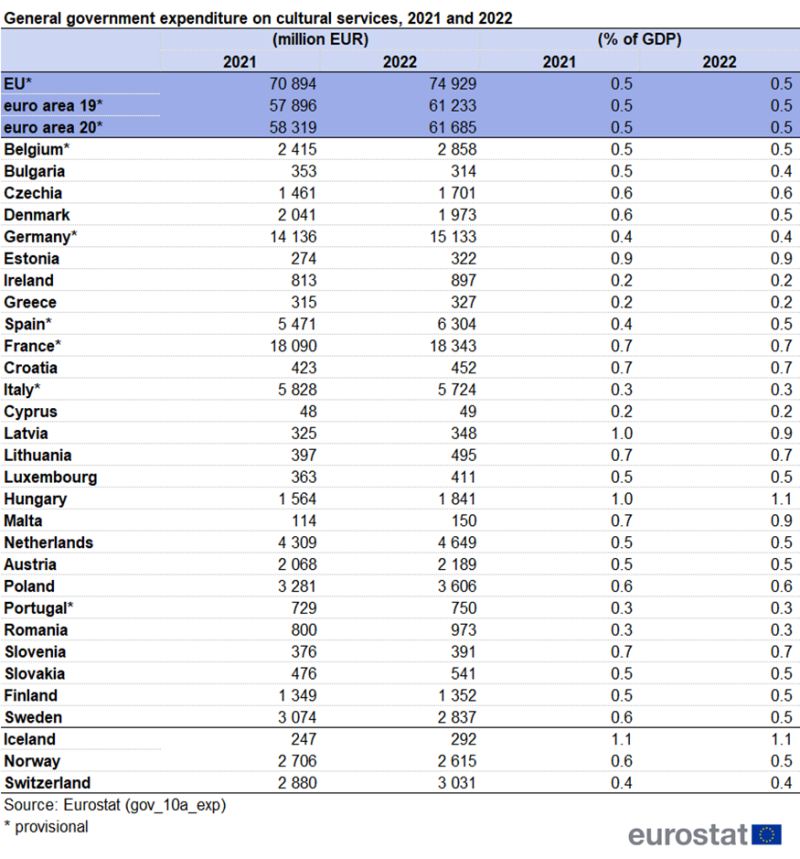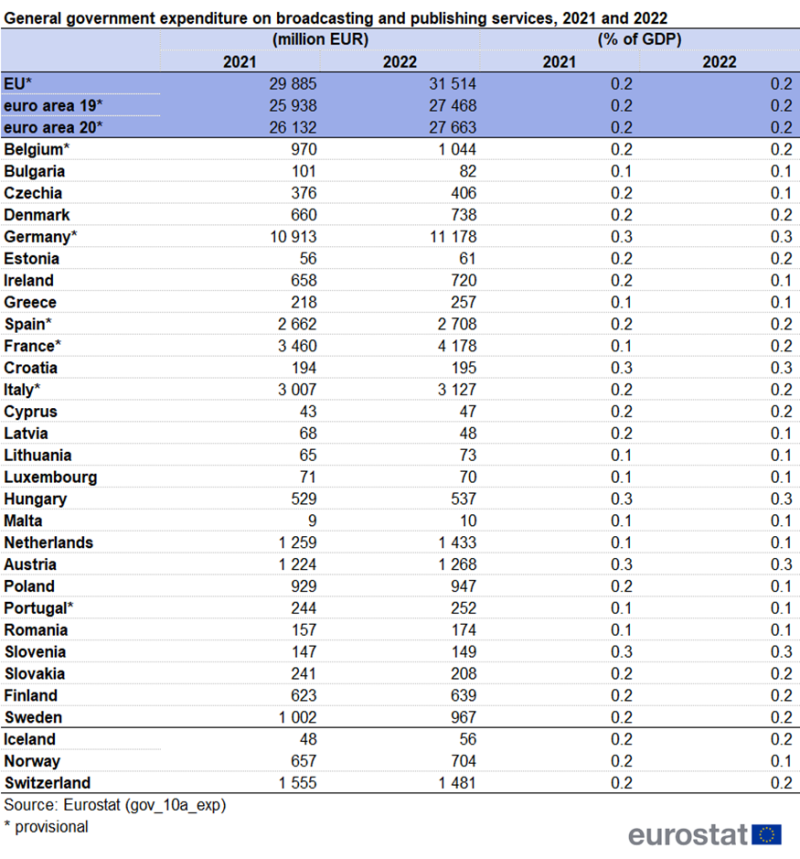Government expenditure on cultural, broadcasting and publishing services
Data extracted on 29 February 2024
Planned article update: February 2025
Highlights
In 2022, general government expenditure across the EU on cultural services amounted to €74.9 billion or 0.9 % of all general government expenditure.

Source: Eurostat (gov_10a_exp)
This article focuses on government expenditure on cultural services as well as on broadcasting publishing services. It is based on data gathered by Eurostat as part of the data collection exercise on government expenditure by the classification of functions of government (COFOG).
General government expenditure on cultural services, broadcasting and publishing services
In the European system of national and regional accounts (ESA 2010), the general government sector is defined as consisting of institutional units which are non-market producers whose output is intended for individual and collective consumption, and are financed by compulsory payments made by units belonging to other sectors, and institutional units principally engaged in the redistribution of national income and wealth. The general government sector comprises central government, state government, local government and social security funds.
The main functions of general government units include organising and redirecting flows of money, goods and services or other assets among corporations, among households, and between corporations and households (examples include the redistribution of national income and wealth), or the production of goods and services to satisfy households’ needs (for example, the provision of state health care or culture to the whole community).
The data presented here concern two COFOG groups (see Data sources section for more details):
- cultural services (08.2); and
- broadcasting and publishing services (08.3).
Full article
General government expenditure on cultural services, broadcasting and publishing services
In 2022, across the EU, approximately 0.9 % of total general government expenditure was allocated to cultural services and around 0.4 % of total general government expenditure was devoted to broadcasting and publishing services.
This percentage remained relatively stable over time within the EU, although there were considerable differences when analysing the results for individual countries (see Figure 1).
In 2022, the highest shares of expenditure on cultural services in total expenditure were recorded in Estonia, Hungary, Latvia and Malta (all 2.2 %), and Lithuania (2.0 %), and among EFTA countries - in Iceland (2.3 %). The lowest shares were observed in Greece (0.3 %), Cyprus and Italy (both 0.5 %).
In absolute terms, EU general government expenditure on cultural services was €74.9 billion in 2022, increasing from €70.9 billion in 2021.
EU general government expenditure on cultural services as a share of GDP stood at 0.5 % in 2022, with this ratio remaining stable at EU level throughout the reported time series from 2001. Between 2021 and 2022, the ratio also remained stable in the majority of the Member States, increased slightly in one Member State and declined in three Member States.
Table 1 shows general government expenditure on cultural services in 2021 and 2022, while Table 2 shows similar information for broadcasting and publishing services (data are shown in absolute values and as a share of all general government expenditure for both reference years).

Source: Eurostat (gov_10a_exp)
In 2022, the highest shares of expenditure on broadcasting and publishing services in total expenditure were recorded in Ireland and Hungary (both 0.7 %), Croatia, Germany and Slovenia (both 0.6 %), as well as Switzerland among EFTA countries (0.6 %). The lowest share was observed in Malta (0.1 %).
In absolute terms, EU general government total expenditure on broadcasting services in 2022 stood at €31.5 billion, up from €29.9 billion in 2021.
EU general government expenditure on broadcasting and publishing services as a share of GDP stood at 0.2 % in 2022, unchanged throughout the reported time series. Between 2021 and 2022, the ratio decreased only slightly in four Member States, while remaining unchanged for all other Member States.

Source: Eurostat (gov_10a_exp)
Source data for tables and graphs
Data sources
Reporting of data to Eurostat
Annual government finance statistics (GFS) data are collected by Eurostat on the basis of the European System of Accounts (ESA 2010) transmission programme. Member States are requested to transmit, among other tables, table 1100, 'Expenditure of general government by function' twelve months after the end of the reference period. Table 1100 provides information about expenditure of the general government sector divided into main COFOG functions and ESA 2010 categories. The transmission of the COFOG I level breakdown (divisions) is compulsory for general government and its subsectors for the years from 1995 onwards, whereas information on the COFOG II level (COFOG groups) is provided on a compulsory basis for general government for the reference years from 2001 onwards. The main reference year used in this publication is 2022 as the latest year available at EU level.
Data was extracted on 29 February 2024.
Provisional data
While a significant effort was undertaken to harmonise the recording of government measures to alleviate the impact of increasing energy prices, a full harmonisation of data for the reference year 2022 was not yet achieved.
Data for the EU and euro area aggregates (2022), Belgium (2022), Germany (2020-2022), Spain (2022), France (2021-2022) and Portugal (2022) is provisional.
Classification of government expenditure by function
General government expenditure by classification of the functions of government (COFOG) is collected at two levels of detail. At its most aggregate level it classifies government expenditure into 10 main functions (divisions or COFOG level I breakdowns): general public services; defence; public order and safety; economic affairs; environmental protection; housing and community affairs; health; recreation, culture and religion; education; social protection. These divisions are further broken down into groups (COFOG level II).
COFOG division 08 for recreation, culture and religion consists of the following COFOG groups:
- 08.1: recreational and sporting services;
- 08.2: cultural services;
- 08.3: broadcasting and publishing services;
- 08.4: religious and other community services;
- 08.5: R&D related to recreation, culture and religion;
- 08.6: recreation, culture and religion not elsewhere classified.
Among these six groups, cultural services and broadcasting and publishing services are those which account for a majority of culture-related government expenditure in the EU. Culture-related items cannot be distinguished in data for Groups 08.5 and 08.6.
Cultural services covered by COFOG Group 08.2 include:
- the provision of cultural services;
- administration of cultural affairs;
- supervision and regulation of cultural facilities;
- operation or support of facilities for cultural pursuits (libraries, museums, art galleries, theatres, exhibition halls, monuments, historic houses and sites, zoological and botanical gardens, aquaria, arboreta, etc.);
- production, operation or support of cultural events (concerts, stage and film productions, art shows, etc.);
- grants, loans or subsidies to support individual artists, writers, designers, composers and others working in the arts or to organisations engaged in promoting cultural activities;
- national, regional or local celebrations provided they are not intended chiefly to attract tourists.
Broadcasting and publishing services covered by COFOG Group 08.3 include:
- administration of broadcasting and publishing affairs;
- supervision and regulation of broadcasting and publishing services;
- operation or support of broadcasting and publishing services;
- grants, loans or subsidies to support the construction or acquisition of facilities for television or radio broadcasting;
- the construction or acquisition of plant, equipment or materials for newspaper, magazine or book publishing;
- the production of material for broadcasting and its presentation;
- the gathering of news or other information;
- the distribution of published works.
Further information is available in Eurostat’s manual on sources and methods for the compilation of COFOG statistics — 2019 edition.
Definition of general government total expenditure
Government total expenditure is defined in ESA 2010, paragraph 8.100 by using as reference a list of ESA 2010 categories.
Government total expenditure comprises the following categories:
- P.2, 'intermediate consumption': the purchase of goods and services by government;
- P.5, 'gross capital formation' consists of: (a) gross fixed capital formation (P.51g); (b) changes in inventories (P.52); (c) acquisitions less disposals of valuables (P.53); where
- P.51g, 'gross fixed capital formation': consists of acquisitions, less disposals, of fixed assets during a given period plus certain additions to the value of non-produced assets realised by the productive activity of producer or institutional units. Fixed assets are tangible or intangible assets produced as outputs from processes of production that are themselves used repeatedly, or continuously, in processes of production for more than one year;
- D.1, 'compensation of employees': the wages of government employees plus non-wage costs such as social contributions;
- D.29, 'other taxes on production, payable',
- D.3, 'subsidies, payable',
- D.4, 'property income, payable', consists of : (a) 'interest, payable' (D.41) and (b) 'other property income, payable' (D.42+D.43+D.44+D.45), where
- D.41, 'interest': excludes settlements under swaps and forward rate arrangements, as these are treated as financial transactions in the ESA 2010;
- D.5, 'current taxes on income, wealth, etc., payable';
- D.62, social payments: cover social benefits and pensions paid in cash;
- D.632, 'social transfers in kind - purchased market production';
- D.7, 'other current transfers, payable';
- D.8, 'adjustments for the change in pension entitlements';
- D.9, 'capital transfers payable';
- NP, 'acquisitions less disposals of non-financial non-produced assets': public investment spending. Non-financial non-produced assets consist of land and other tangible non-produced assets that may be used in the production of goods and services, and intangible non-produced assets.
- Capital investments includes P.5 and NP.
- Other current expenditure includes D.29, D.5 and D.8.
Gross Domestic Product
Throughout this publication, nominal GDP, i.e. GDP at current prices is used.
Context
Culture is one of Europe’s greatest assets: it is a source of values, identity and a sense of belonging; it also contributes towards well-being, social cohesion and inclusion. The cultural and creative sectors may also provide a stimulus for economic growth, job creation and international trade.
That is why culture is becoming increasingly important within the EU. In accordance with Article 167 of the Lisbon Treaty, the EU shall contribute to the flowering of the cultures of the Member States, while respecting their national and regional diversity and at the same time bringing the common heritage to the fore.
The EU supports these objectives through the Creative Europe programme, as well as a number of policy actions set out in the Work Plan for Culture (2015-2018) and the Work Plan for Culture (2019-2022). The latter, adopted by EU culture ministers in November 2018, sets out the main priorities for European cooperation in cultural policymaking: sustainability in cultural heritage; cohesion and well-being; an ecosystem supporting artists, cultural and creative professionals and European content; gender equality; and international cultural relations.
The production of reliable, comparable and up-to-date cultural statistics, which provide a basis for sound cultural policymaking, is a cross-sectorial priority in the latest work plan. Eurostat collates culture statistics from several different data collections to provide policymakers and other users with information on the main developments in the field of culture, covering issues such as education, employment, business, international trade, participation and consumption patterns.
Direct access to
- Government expenditure on recreation, culture and religion
- Government expenditure by function - online publication
- Government finance statistics
- Culture (all Statistics Explained articles on/related to culture)
- Government statistics (gov)
- Government finance statistics (EDP and ESA 2010) (gov_gfs10)
- Annual government finance statistics (gov_10a)
- Government revenue, expenditure and main aggregates (gov_10a_main)
- General government expenditure by function (COFOG) (gov_10a_exp)
- Annual government finance statistics (gov_10a)
- Government finance statistics (EDP and ESA 2010) (gov_gfs10)
- Manual on sources and methods for the compilation of COFOG statistics — classification of the functions of government (COFOG) — 2019 edition
- Manual on government deficit and debt — implementation of ESA 2010 — 2022 edition
- General government expenditure by function (COFOG) (ESMS metadata file — gov_10a_exp_esms)
- Guide to Eurostat culture statistics — 2018 edition
- European statistical system network on culture (ESSnet-Culture final report (2012))